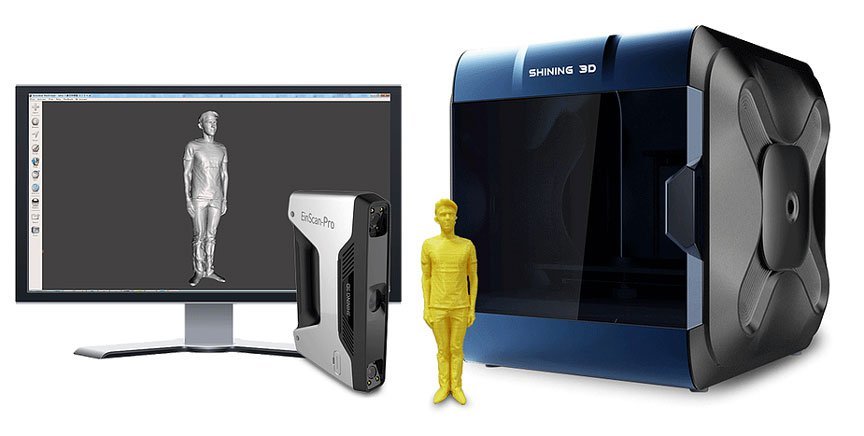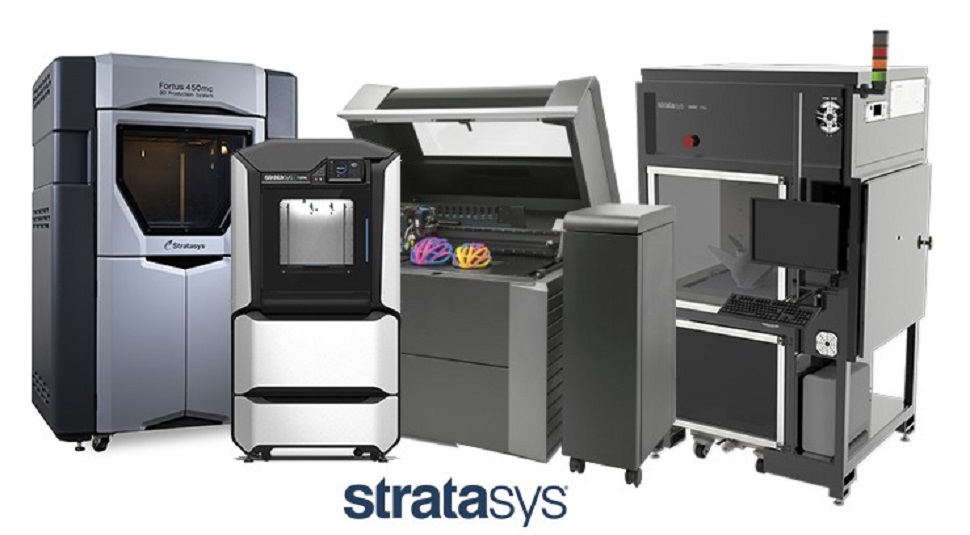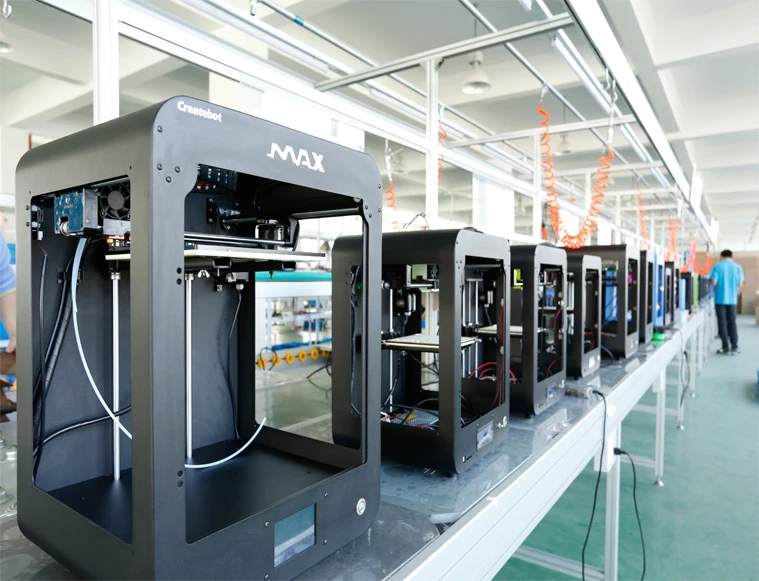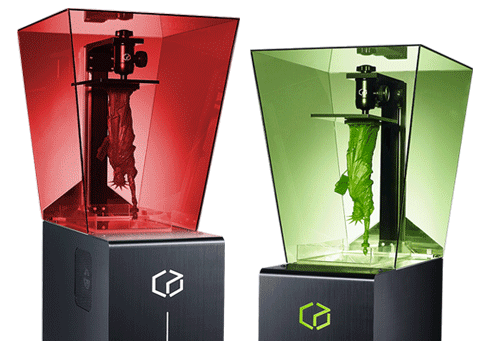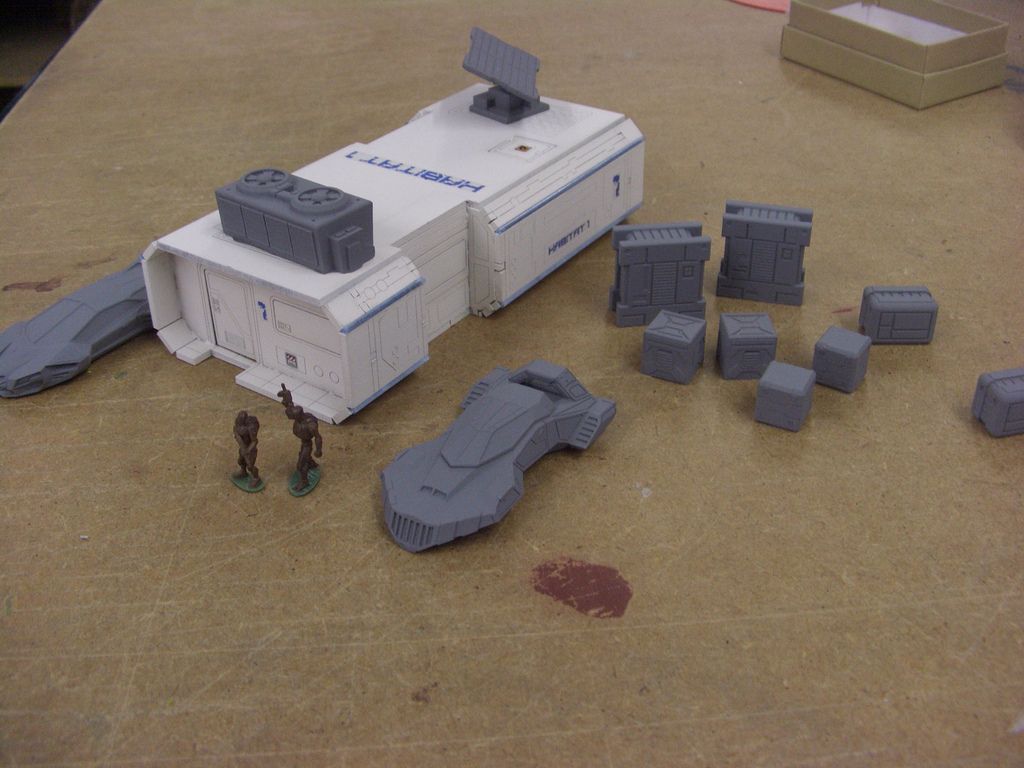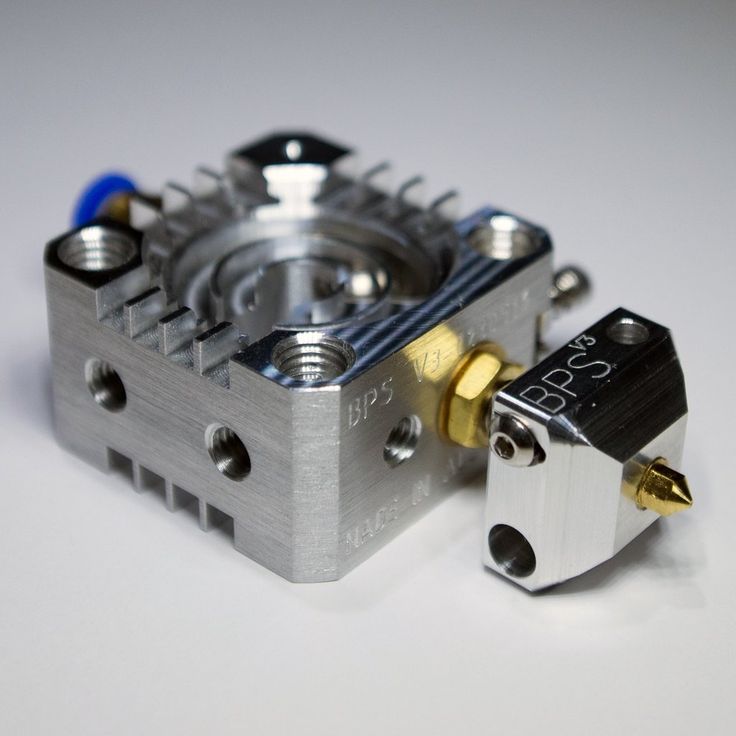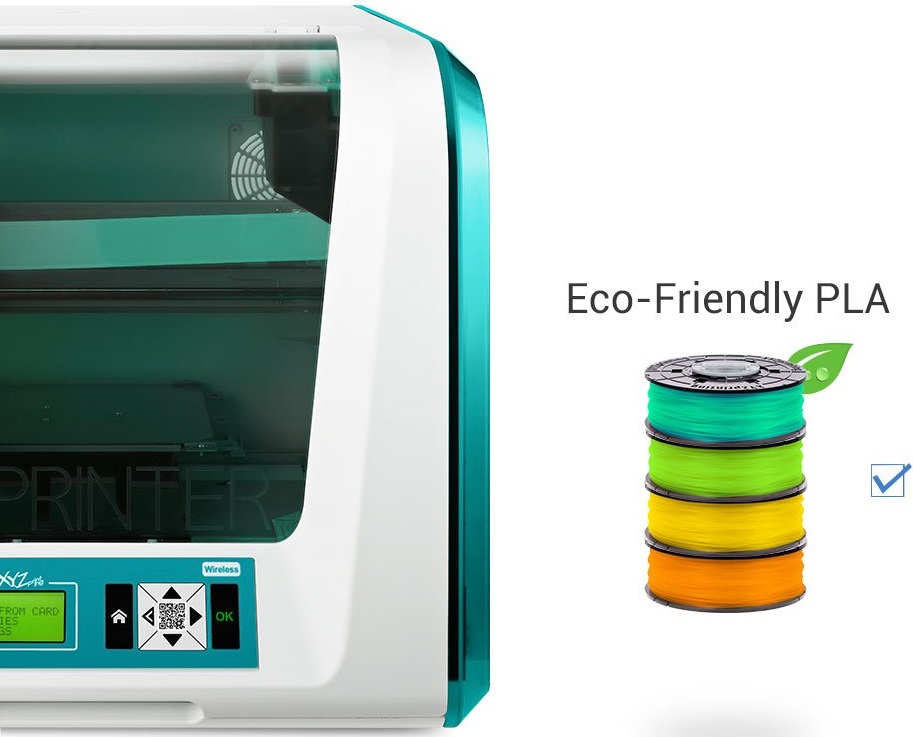3D scanners for reverse engineering
3D scanners for reverse engineering — best Artec 3D scanning solutions
Applications
HD meshes for CAD workflows
Confidently and easily capture data from existing parts with the assurance of ultra-high precision and accuracy.
Rapid prototyping
With tools that seamlessly integrate into your existing workflow, you can quickly and easily prototype, test, and get insightful feedback on design solutions.
Retrofitting
Redesigning parts that are no longer in production has never been easier, with none of the errors, inconsistencies, and time demands that come with taking measurements manually.
Aftermarket parts production
With reliable 3D scan datasets, paired with Artec Studio’s versatility, you have the ability to develop high-quality aftermarket parts.
Additive manufacturing
You can take advantage of the flexibility that 3D printing brings to quickly actualize and test reverse-engineered designs.
A leading developer of high-performance chassis saves days of work by using Artec Eva, Artec Studio, and Geomagic Design X to engineer custom solutions for racing.
7x
reduction in time spent capturing and processing scans.
“Eva has been such a game-changer. Now I’ll take a bunch of parts and scan them in before lunch. By the end of the day, we’ve done all our analysis, everything is on schedule to create the final design.”
Jason Heard, Co-founder, Tekk Consulting Inc.
Read full story
In the media
Royal Netherlands Navy 3D scans their ships using handheld Artec 3D scannersTHE VERGE
Classic Land Rover goes electric with the help of Artec LeoTop Speed
3D scanning ensures cameras will mount to helicoptersMake Parts Fast
User-friendly portable 3D scanner with an inbuilt touchscreen and intuitive UI for easy 3D scanning.
Learn more
Our bestselling 3D scanner. Fast, versatile, and accurate.
Fast, versatile, and accurate.
Learn more
A metrological structured-light 3D scanner, set apart with its ability to render complex geometry, sharp edges, and thin ribs in high precision.
Learn more
Powerful long-range laser 3D scanner with an inbuilt battery, for precise capture of large objects.
Learn more
Metrology-grade desktop 3D scanner for quality control, inspection, jewelry, medical/dental components, etc.
Learn more
Using Artec 3D scanning technology to keep Dutch Royal Navy ships seaworthy
“We are now able to work a lot faster and more accurately. Because we now have a complete 3D model, we have all the correct dimensions of every object. It results in a far more efficient way of working and it is faster, so we save a lot of money in these projects.”
Ben Jansen, CNC coordinator at the Netherlands Defense Ministry
Read full story
Reverse engineering huge machine parts in difficult locations with Artec Eva and Geomagic Design X
“Artec Eva was the suitable scanner for this job as the parts were very big and the accuracy required was in the range of Artec Eva’s accuracy. The scanning was pretty fast and easy considering that those were huge parts, around 3 meters…No other scanner can measure such big parts this accurately and fast.”
The scanning was pretty fast and easy considering that those were huge parts, around 3 meters…No other scanner can measure such big parts this accurately and fast.”
Ali Can Boysan, Teknodizayn Sales & Technical Support Manager
Read full story
Putting Claws on the Black Panther Lexus with Artec Eva at West Coast Customs
“It's a huge help that Eva is lightweight and comfortable to hold, which makes scanning actually fun to do … you don’t need to use it for long before you look over at the laptop and realize that you’ve scanned the whole car … it either would’ve been just impossible without Eva or much more difficult and definitely not as precise.”
Lorenzo Strong, West Coast Customs Sales VP
Read full story
Slashing weeks off reverse engineering farm equipment with Artec Eva
“Eva has literally saved us days if not weeks of work, and that’s no exaggeration.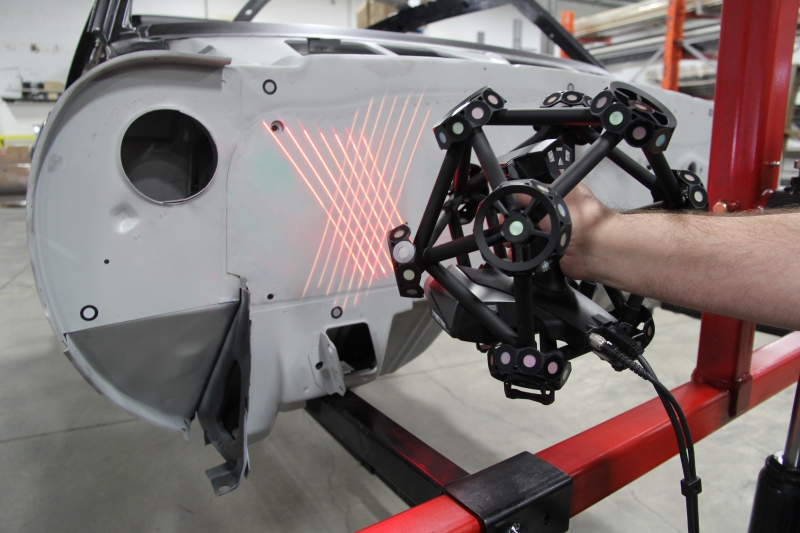 Previously we were spending all that time creating prototypes to test, then that many more hours on alterations to reach the level of perfect, compared to now achieving perfection the first time, and every time, with Eva.”
Previously we were spending all that time creating prototypes to test, then that many more hours on alterations to reach the level of perfect, compared to now achieving perfection the first time, and every time, with Eva.”
Mark Taylor, Taylor Attachments
Read full story
User-friendly portable 3D scanner with an inbuilt touchscreen and intuitive UI for easy 3D scanning.
Learn more
Our bestselling 3D scanner. Fast, versatile, and accurate.
Learn more
A metrological structured-light 3D scanner, set apart with its ability to render complex geometry, sharp edges, and thin ribs in high precision.
Learn more
Powerful long-range laser 3D scanner with an inbuilt battery, for precise capture of large objects.
Learn more
Metrology-grade desktop 3D scanner for quality control, inspection, jewelry, medical/dental components, etc.
Learn more
Complex motorcycle engine captured by Artec Leo in just 8 minutes
Artec Leo
Pipe bend captured with Artec Micro in only two scans over four minutes
Artec Micro
Motorcycle crankcase captured by Artec Space Spider in 15 minutes
Artec Space Spider
Compound bow captured by Artec Eva in just five minutes
Artec Eva
Artec Ray was used to scan an airplane suspended three meters high.
Artec Ray
3D Scanners for Reverse Engineering
Hi everyone! This is Top 3D Shop, and in the following review, we will talk about reverse engineering, the considerations when choosing 3D equipment for it, and related case studies.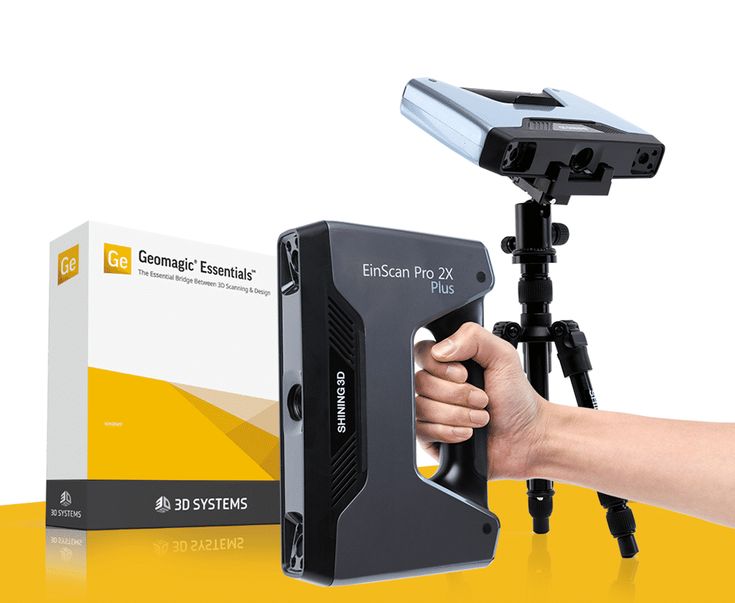
Read on to learn more.
What is reverse engineering?
Source: 3daeroscan.com
Reverse engineering, also known as back engineering, is the process of creating a project of parts or products with no drawings or documentation. By creating a digital CAD model using 3D scanning, these parts can be modified and optimized to extend their lifetime or add new functions. This method is used in many industries, including the production of military equipment or spacecraft.
With the growing popularity of 3D printing, reverse engineering is gaining ever-increasing attention. This is due to the fact that the reproduction of an object or design using digital modeling and 3D printing is more accessible to ordinary users than other production processes.
The ICON company uses a variety of 3D scanners to reverse engineer vintage car parts.
Source: 3dreveng.com
The process of reverse engineering involves three tasks: obtaining a sufficiently accurate digital impression of a part, converting the resulting image into a solid 3D model in specialized software, and subsequent digital processing of the model to eliminate artifacts, convert the format, and make some modifications so that the model design is suitable for the product launch.
Therefore, it is necessary to choose the right 3D scanner to obtain the primary data that best suits the existing task. For example, it is completely pointless to scan a piece of jewelry with a time-of-flight scanner for large objects, and vice versa: the very high accuracy of a desktop or handheld scanner is redundant when scanning, for instance, a sea vessel.
NeoMetrix Technologies uses the Creaform HandySCAN 700 3D scanner for reverse engineering and metrological control of various objects.
Stages of reverse engineering
Source: 3dcaptura.cz
1. Prepare the object for scanning, apply markers if necessary. Note that glossy surfaces impede the work of 3D scanners, and reflective or transparent ones are nearly impossible to scan without a matte finish, so spray a temporary matte powder on the object to improve scanning accuracy.
2. Use a 3D scanner to capture important areas of the part. You may need to orient and rescan your object several times if it has holes or deep grooves.
3. Adjust and optimize the resulting polygonal mesh. Some scanners create very large files, making it difficult to post-process and print an object. Remove artifacts, check the surface stitch.
4. Import the mesh into CAD software equipped with reverse engineering tools.
5. Convert polygons to solids.
6. If necessary, add new objects to the resulting 3D model or delete unnecessary ones.
7. Use 3D printers or CNC machines to produce a new part according to the created model.
Reverse engineering of automotive parts with a Creaform 3D scanner using the VXmodel and Autodesk Inventor software
Case studies
Reverse engineering of an impeller
Source: 3d-scantech.com
An equipment manufacturer needed to optimize the production of impellers and eliminate manufacturing variances. It proved impossible to obtain accurate data of a part with holes, dead angles, and geometrically complex surfaces by traditional means. The impeller has narrow gaps between the vanes, which prevents measurement with a probe, so it was decided to employ 3D laser scanning and process the results using reverse engineering methods for comparison with the original digital model.
Source: 3d-scantech.com
3D scanning was performed by means of the ScanTech PRINCE high-precision 3D scanner with red and blue laser scanning modes.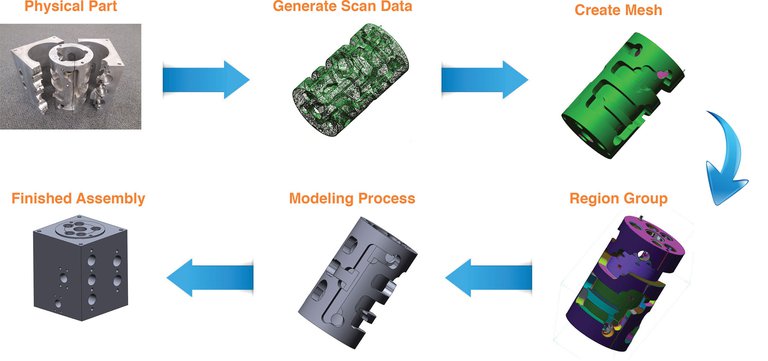 The device has a resolution of 0.020 mm and can quickly switch between modes. It is capable of scanning deep holes with a single red laser line and capturing the smallest details. In addition, the scanner is insensitive to ambient light.
The device has a resolution of 0.020 mm and can quickly switch between modes. It is capable of scanning deep holes with a single red laser line and capturing the smallest details. In addition, the scanner is insensitive to ambient light.
Source: 3d-scantech.com
A full detailed model of the impeller housing with vanes was obtained using the 3D scanner.
Source: 3d-scantech.com
A complete digital model was created for analysis.
Creating an audio speaker cart using reverse engineering
Source: shining3d.com
To participate in a sports and dance event called Colorguard, a captain had to do something for her team. She decided to create a cart for a heavy speaker that girls use to play music during training and performance. The speaker was to be easily removed from the cart if necessary. Besides, one of its handles needed restoration.
The speaker has three identical handles attached with screws. To replace the broken handle with a new one, the EinScan-SP was used to scan one of the remaining handles. Since the handle was very dark, it was dusted with a thin layer of baby powder so that the scanner could correctly recognize the surface. The EinScan-SP has the function of automatically stitching images when the object is rotated on the turntable and in different positions of the object. The program selects certain points from several scans and connects them. This allows users to scan not only the sides but also the top and bottom of the object.
To replace the broken handle with a new one, the EinScan-SP was used to scan one of the remaining handles. Since the handle was very dark, it was dusted with a thin layer of baby powder so that the scanner could correctly recognize the surface. The EinScan-SP has the function of automatically stitching images when the object is rotated on the turntable and in different positions of the object. The program selects certain points from several scans and connects them. This allows users to scan not only the sides but also the top and bottom of the object.
Source: shining3d.com
To clean up the resulting image from artifacts and eliminate any damage on the handle, the Deform: Smooth tool in the free Autodesk Meshmixer utility was used. Using the Edit: Erase and Fill tools, the existing manufacturer's logo was removed, with the event logo added. Meshmixer was also used to make sure the screw holes were cylindrical. Processing the resulting STL file in Meshlab simplified the model and reduced the file size from 26 to 2. 4 Mb.
4 Mb.
Source: shining3d.com
The handle was printed using the Afinia H+1 3D printer with a TPU extruder and NinjaTek's Cheetah flexible filament. For greater rigidity, 80% filling was used. The resulting handle turned out both durable and pleasant to touch.
Source: shining3d.com
After examination, it was decided to use the speaker mount holes as attachment points to the cart. Measurements with a caliper would have taken plenty of time, it was more efficient to use the Shining 3D EinScan Pro 2X Plus portable 3D scanner. Markers were applied for better surface capture.
Source: shining3d.com
Although the EinScan Pro 2X Plus comes with the Solid Edge software (a complete CAD package with reverse engineering capabilities), it was decided to use Autodesk Fusion 360 because the user was more comfortable with it.
Source: shining3d.com
The resulting 3D model was too large to be printed in one piece, so it was split into two parts. It was printed with black PLA.
It was printed with black PLA.
Source: shining3d.com
The print path was optimized to increase the strength of the cylinder and walls.
Source: shining3d.com
The cart handle was made of acetone-welded ABS plastic, and a piece of chipboard was used to make the base plate.
Reverse engineering of stamping dies
Source: metrology.news
Gestamp is an international company engaged in the design, development, and hot stamping manufacture of metal automotive parts for major carmakers. In modern production, there occurs a situation when changes are made to a CAD-designed die directly in production. Manufacturers often forget to reflect such changes in the documentation/original model. As a result, when a die is replaced on account of wear or damage, engineers have to make undocumented changes anew, which leads to errors and an increase in flaws.
Source: metrology.news
This situation can be fixed with the use of reverse engineering. After a die is set and configured, it is scanned and all the changes are recorded in the digital model. The resulting file, which fully corresponds to the scanned surface including the smallest details, is used for reverse engineering of the die. Changes identified using this method are incorporated into the original 3D model of the die.
After a die is set and configured, it is scanned and all the changes are recorded in the digital model. The resulting file, which fully corresponds to the scanned surface including the smallest details, is used for reverse engineering of the die. Changes identified using this method are incorporated into the original 3D model of the die.
Source: metrology.news
Gestamp specialists work with the Creaform HandySCAN 3D scanners, appreciating their accuracy, convenience, and compatibility with reverse engineering software.
Footwear design using reverse engineering
Source: rangevision.com
RangeVision specialists investigated the possibility to speed up reverse engineering of objects with a large number of surfaces that change their curvature in accordance with mathematical laws. They used the sole of sports shoes as a test surface with such properties.
Source: rangevision.com
For this, they performed a 3D scan of the sole's geometry using the RangeVision Spectrum high-resolution 3D scanner (adjusted for object sizes from 30 cm to 1 m) and a rotary table. In 25 minutes, the device completed two groups of 8 scans, which were automatically linked into one model by the scanner software. Post-processing in the RangeVision ScanCenter program and obtaining a 3D model in .stl format took another 35 minutes.
In 25 minutes, the device completed two groups of 8 scans, which were automatically linked into one model by the scanner software. Post-processing in the RangeVision ScanCenter program and obtaining a 3D model in .stl format took another 35 minutes.
Source: rangevision.com
Reverse engineering of the sole was carried out in Geomagic Studio using the NURBS method. First of all, artifacts and digital noise were removed, a coordinate system was created, unnecessary details were cut off, and the boundaries were smoothed.
Source: rangevision.com
After applying the NURBS method to the resulting surface, the final 3D model was created. Reverse engineering using NURBS took 4 hours. The entire task was completed within one working day.
Scanning of different objects, DE-Engineering
Source: rangevision.com
The DE-Engineering company fulfills orders on high-precision 3D digitizing and reverse engineering of various objects, from aircraft to jewelry. The founder Dmitry Epstein maintains a video blog on YouTube, in which he publishes the most interesting works. DE-Engineering uses the RangeVision PRO and Gom Atos 3D scanners.
The founder Dmitry Epstein maintains a video blog on YouTube, in which he publishes the most interesting works. DE-Engineering uses the RangeVision PRO and Gom Atos 3D scanners.
Source: rangevision.com
3D scanning of large objects, such as the frame of a helicopter or an airplane, has some peculiarities: to save time, markers are glued with strips of masking tape, and scanning is carried out from several points to facilitate stitching of the model.
Source: rangevision.com
For the armoring of two Citroen Jumpy vehicles, DE-Engineering specialists performed 3D scanning of the body and created an accurate model, according to which the metal plates were manufactured. The high precision of reverse engineering made it possible to install the armor without any additional fit. The whole process took seven days — two days for scanning and five days for processing.
Source: rangevision.com
DE-Engineering tries to use point cloud processing instead of polygons, which is more convenient from the point of view of model simplification. This allows maximizing the detail of an object in complex geometry areas and reducing it in simple ones. Processing is performed with the Catia software. Replaceable lenses are used to scan jewelry.
3D scanning in reverse engineering of a complex-shaped part, Top 3D Shop
A client contacted Top 3D Shop with a request to restore a broken plastic part of a complex shape.
The part was created by 3D scanning with the RangeVision Pro, reverse engineering, and 3D printing.
Step 1. The length of the part is about 30 cm, so it was impractical to use medium-precision handheld scanners and solutions for large objects. Desktop scanners with a multi-axis table were not suited either, because the object did not fit in length into the half-open scanner camera. Thus, stationary optical or high-precision handheld scanners seemed to be the only options.
Desktop scanners with a multi-axis table were not suited either, because the object did not fit in length into the half-open scanner camera. Thus, stationary optical or high-precision handheld scanners seemed to be the only options.
Step 2. The object has a geometry of medium complexity. For good scanning of such parts, a scanner accuracy of 40–60+ microns is required.
In the images: solid models of the object with the restored integrity
Step 3. The higher the accuracy of a 3D scanner and the more features it has, the more expensive it is. The customer's budget did not allow the use of GOM, Solutionix, or Scantech scanners, so Top 3D Shop employed the RangeVision Pro, which scans such small objects with an accuracy of 40 microns. Based on the data obtained from 3D scanning, reverse engineering was performed, and the part was prepared for printing.
How to choose a 3D scanner for reverse engineering
First of all, it is necessary to define the size of the scanned objects — this affects the choice of scanning technology and the type of scanner (desktop, handheld, or floor-standing):
- For objects larger than 10 m in any of the coordinate axes, 3D scanners with the usual laser triangulation or structured light technologies are not suitable.
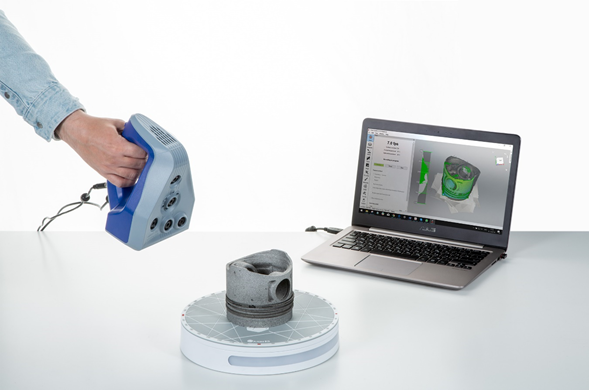 Scanning such objects even with a handheld scanner will take a lot of time, and the accuracy of data decreases. This problem is partially solved by photogrammetry. Therefore, for very large objects (airplanes, ships, buildings), it is most effective to use time-of-flight (ToF) scanners.
Scanning such objects even with a handheld scanner will take a lot of time, and the accuracy of data decreases. This problem is partially solved by photogrammetry. Therefore, for very large objects (airplanes, ships, buildings), it is most effective to use time-of-flight (ToF) scanners. - For objects larger than 50 cm but less than 3 m, it is recommended to use handheld scanners — optical or laser ones.
- For objects from 10 to 50 cm, stationary desktop or portable floor-standing 3D scanners suit best (both optical and laser). Optical desktop and floor-standing scanners are more affordable than laser ones. Some handheld laser scanners can be used for tasks requiring high scanning speed.
- Desktop high-precision optical scanners are best for small objects. Scanners of this type can be divided into two groups: dental and versatile.
Dental scanners feature immensely high precision, high resolution, and rotary tables with the ability to attach an occluder and impression stands.
Versatile scanners are usually equipped with a multi-axis rotary table, or the scanner itself is fixed on axes with several degrees of freedom. This design allows for autonomous scanning of most of the object's surface. These scanners have a good scanning depth to correctly capture grooves.
For objects with a size of 10–50 cm, laser handheld scanners are better suited if at least one of the following conditions is met:
- 3D scanning is planned to be used very often;
- the object to be scanned cannot be transported to the workshop; for example, it is a non-removable part of a massive mechanism, or transportation is impossible for other reasons;
- there is not enough room to place a stationary scanner;
- the surface of an object is difficult to scan with optics — it is black or highly reflective.
After defining the size of scanned objects, it is important to find out the required scanning accuracy and the measurement tolerance and see whether a metrological scanner is needed.
Reverse engineering of car parts at Jay Leno's Garage using the Faro Quantum ScanArm HD 3D laser scanner and the Stratasys Dimension 1200es 3D printer
Software for modeling and reverse engineering
Software for creating polygon models
Source: all3dp.com
To create point clouds and polygon models, it is usual to employ the proprietary software of a 3D scanner. Some 3D scanning and reverse engineering software products can also work directly with the most popular scanners.
Software for converting polygon models into solid ones
Geomagic Essentials
Source: einscan.com
Geomagic Essentials is a program that extracts all the necessary elements of a scanned part for direct use in a CAD package. This software is designed to work with scans made by the Shining 3D EinScan Pro 2X (a joint product of 3D Systems and Shining 3D), which automatically processes and transfers the received data to the CAD environment. The application can be used both for metrological control and reverse engineering of parts and assemblies. The proprietary algorithms of mesh alignment and restoration, a wide range of options for fitting elements, the capability of creating cross sections, and high performance when working with large amounts of data can significantly reduce the work time of specialists.
The application can be used both for metrological control and reverse engineering of parts and assemblies. The proprietary algorithms of mesh alignment and restoration, a wide range of options for fitting elements, the capability of creating cross sections, and high performance when working with large amounts of data can significantly reduce the work time of specialists.
Employing Geomagic Essentials to reverse engineer fan blades by user Gregory George
Geomagic Design X
Source: 3dsystems.com
Geomagic Design X is versatile professional reverse engineering software that combines traditional CAD functionality with 3D scan data processing. Design X allows creating functional, editable solid models compatible with CAD software. The proprietary algorithms for accurate surface fit to 3D scans, mesh editing, and point cloud processing enable the design of components that perfectly integrate with existing parts.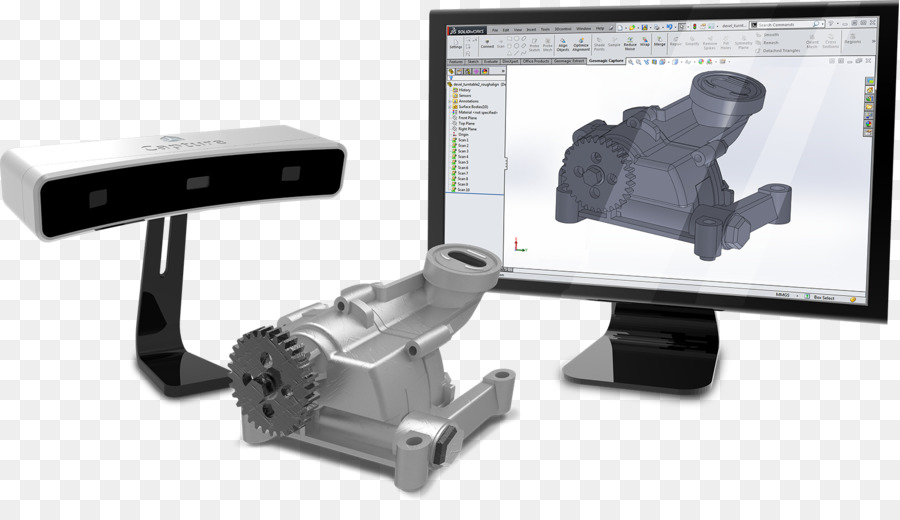 The easy-to-use mesh repair tools provide fast hole filling, smoothing, optimization, and comparison with the original model.
The easy-to-use mesh repair tools provide fast hole filling, smoothing, optimization, and comparison with the original model.
Reverse engineering of a compressor at Artec 3D using 3D scanning and the Geomagic Design X software
Autodesk Meshmixer
Source: all3dp.com
Autodesk Meshmixer is completely free software popular with 3D printing professionals. Meshmixer is designed for working with polygonal meshes rather than for parametric modeling and has a large set of tools for this. The functions of automatic analysis and correction are very convenient for processing 3D scans. The program is also capable of preparing a model for 3D printing, including supports. Meshmixer is simple and easy to use, with many tutorials available online.
The first video by AutoDesk to demonstrate the capabilities of Meshmixer
Software for working with solid models
SolidWorks
Source: blog.trimech.com
SolidWorks is a 3D design and reverse engineering program. Apart from traditional CAD/CAM functions, the software includes specialized tools for designing sheet metal parts, welds, and dies. A huge library of components and parts, improved realistic rendering, the capability of design check and structure analysis make SolidWorks one of the most powerful 3D engineering software products available.
The first video from the series of SolidWorks software tutorials: reverse engineering and 3D scan processing
Solid Edge
Source: youtu.be
Solid Edge is an easy-to-learn toolset that covers all phases of product development: CAD design and rendering, modeling, reverse engineering, data management, and more. Siemens also provides training resources, access to the Solid Edge community, and ongoing software updates. If certain conditions are met, Solid Edge Premium can be used free of charge for one year.
Siemens also provides training resources, access to the Solid Edge community, and ongoing software updates. If certain conditions are met, Solid Edge Premium can be used free of charge for one year.
Demonstration of the capabilities of Solid Edge 2021 from Siemens Software
Autodesk Fusion 360
Source: all3dp.com
The Autodesk Fusion 360 software and all of its modules are free for students, educators, hobbyists, and small businesses. The program is designed primarily for working with solid objects and is equipped with functional plug-ins.
Reverse engineering of a plastic housing at Dream3D using the HDI 3D scanner and the Autodesk Fusion 360 software
Legal issues of reverse engineering
Source: scantech. com
com
The dark side of reverse engineering is intellectual property forgery and theft. The growing availability of the technology can give an advantage to unscrupulous manufacturers when legislation lags behind modern requirements. This means that prototypes that took developers a lot of time and money can be counterfeited with impunity using 3D scanning and printing technologies.
The ease of copying product designs forces large companies to experiment with ways to protect their intellectual rights — for example, by creating product defects that appear only in unauthorized production, or by embedding authentication barcodes directly into manufactured products.
Full 3D scanning and reverse engineering of a car body using the Creaform Go!SCAN SPARK 3D scanner.
Conclusion
Source: ductim-x.com
The future of reverse engineering lies in even greater process automation. Manufacturers are increasingly employing the power of artificial intelligence and cloud technologies in scanning and post-processing to enable inexperienced clients to carry out their work autonomously. This can be useful for specialists in a variety of fields, from doctors scanning body parts to workers on construction sites. 3D scanners keep on penetrating the consumer market and may eventually become as commonplace as cameras on smartphones (some of them are already equipped with a ToF sensor).
Manufacturers are increasingly employing the power of artificial intelligence and cloud technologies in scanning and post-processing to enable inexperienced clients to carry out their work autonomously. This can be useful for specialists in a variety of fields, from doctors scanning body parts to workers on construction sites. 3D scanners keep on penetrating the consumer market and may eventually become as commonplace as cameras on smartphones (some of them are already equipped with a ToF sensor).
3D scanning for reverse engineering
In this review, we will talk about reverse engineering, considerations when choosing 3D equipment for it, and related case studies.
Contents:
- What is Reverse Engineering or Reverse Engineering of Products
- Reverse Engineering: Quality Data, Quality Products
- Automated 3D Scanning System
- RobotScan E0505 Automated Quality Control System: Efficient 3D Scanning of Products in serial production
- Features and Benefits of RobotScan E0505
- Handheld 3D Scanner in Production
- EinScan HX: Handheld 3D Scanner for Industrial Applications
- Reverse Engineering Workflow Optimization
- DigiMetric: New Generation 9000 Optical 3D Coordinate Measuring Machine
- Reverse Engineering Steps
- Use Cases
Read on to find out more.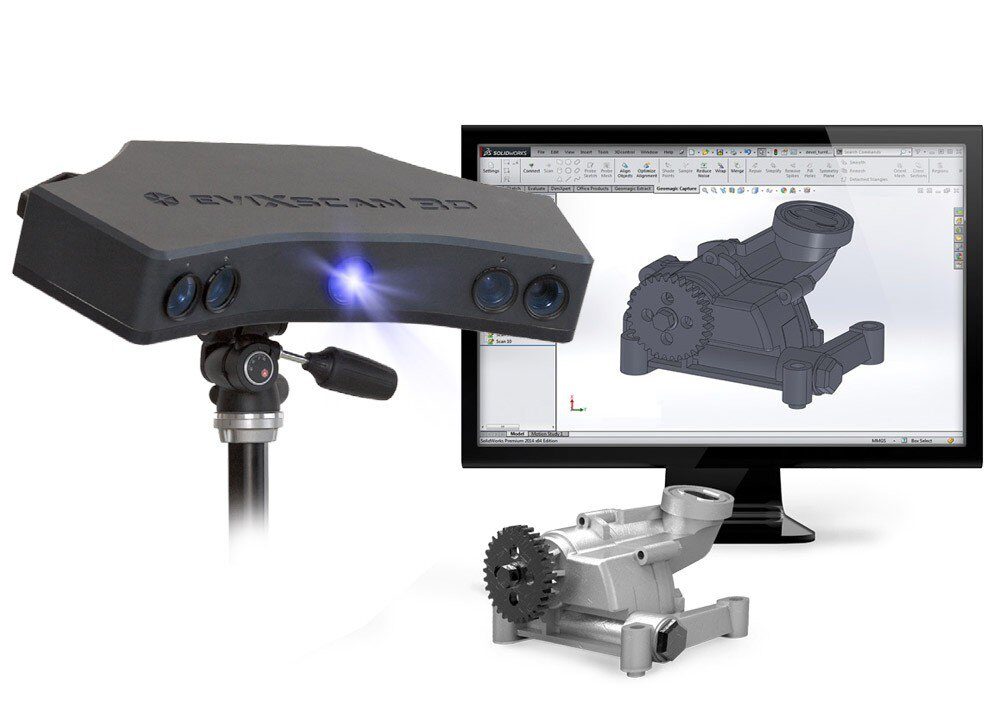
What is reverse engineering or reverse engineering of products
Reverse engineering, also known as reverse engineering or reverse engineering, is the process of creating a design of parts or products for which there are no drawings or documentation. By creating a digital CAD model using 3D scanning, these parts can be modified and optimized to extend their lifespan or add new features. This method is used in many industries, including the production of military equipment or spacecraft. nine0003
In manufacturing, reverse engineering allows the production or reproduction of physical objects using the physical object itself as a guide. This process is only possible when using an accurate 3D scanner to collect data from the object's surface. This data defines the geometric identity of the object, containing the specifications that create the model for the production of the object. 3D scanning allows designers, fabricators and engineers to create exact digital twins of physical parts. While this capability makes reverse engineering faster and easier, not every 3D scanning solution is perfect for every reverse engineering project. nine0003
While this capability makes reverse engineering faster and easier, not every 3D scanning solution is perfect for every reverse engineering project. nine0003
Precision 3D scanners provide reverse engineering capability, allowing engineers to use accurate 3D measurement data to reproduce objects as they were manufactured. With high-resolution data and intelligent metrology software, manufacturers can take their reverse engineering projects one step further by using the resulting scan data to model and evaluate modifications and improvements to an object before it is physically manufactured. nine0003
With the booming 3D scanning industry, there are more options for reverse engineering scanners than ever before. However, it can be difficult to determine which 3D scanner is best for your reverse engineering project. For example, handheld 3D scanners have become a popular choice due to their affordability and compactness. However, depending on the specific characteristics of your project, it may be better to choose a different 3D scanning solution.
We've put together a list of everything you need to know about precision 3D scanners that support fast and efficient reengineering for manufacturing. nine0003
Reverse Engineering: Quality Data, Quality Products
The purpose of reverse engineering is to recreate a physical part or object without using a digital file or computer-aided design (CAD) model. Instead, an accurate 3D scanner is used to collect data from the surface of the physical part, resulting in an STL file (or other form) that becomes a digital twin of the part. With this data, the part can be reproduced, improved or archived. nine0003
The best 3D scanner for reverse engineering is usually non-contact blue light 3D scanning due to its speed, accuracy and ease of use.
Every part or product requires a model to manufacture, but when you reverse engineer a product, the model is created from the object. For the reverse engineering process to be successful, the data that makes up the model must be accurate and of high resolution.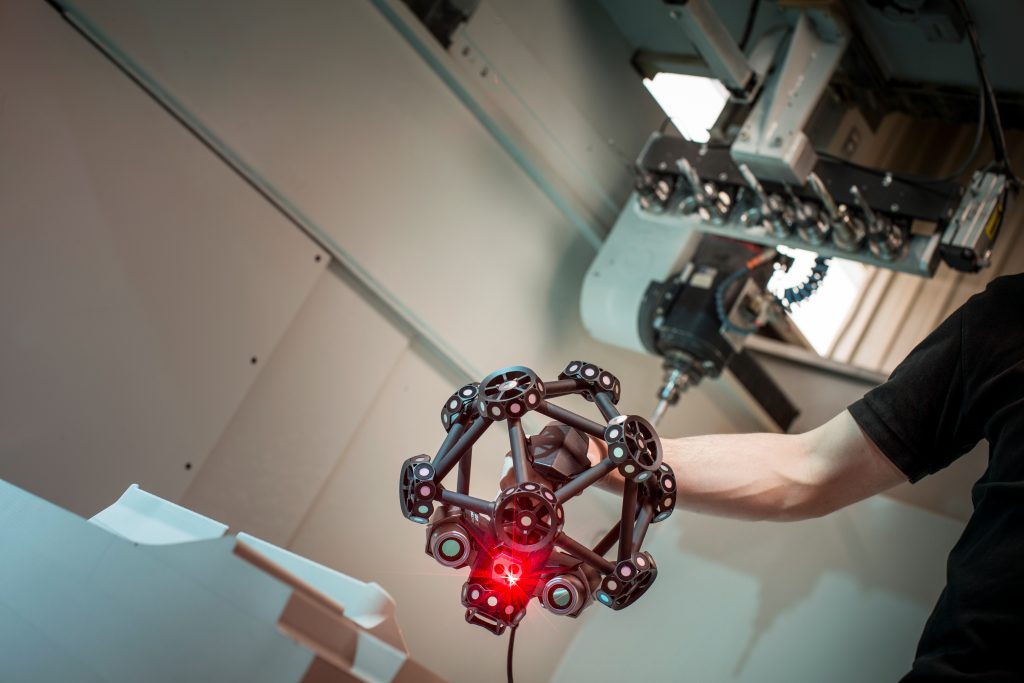
Qualitative data is very important for reengineering, as it will guide you when recreating a part or object. Noisy or poor-quality data can slow down the reengineering process because it is impossible to create a model with complex geometric shapes. You end up wasting time re-scanning parts in the hope of gathering enough data to continue with the reengineering process. nine0003
To make sure you have the best reverse engineering 3D scanner, consider what exactly you will be using it for.
Automated 3D Scanning System
Automated 3D Scanners are the ideal metrology solution for the manufacturing floor because the scanning unit is attached to a mechanical arm that slowly and steadily collects accurate 3D measurement data from the surface of an object. Automated 3D scanners help speed up 3D measurement processes and speed up repetitive measurements. nine0003
Although handheld 3D scanners are accurate solutions, they can affect efficiency in the production of small parts.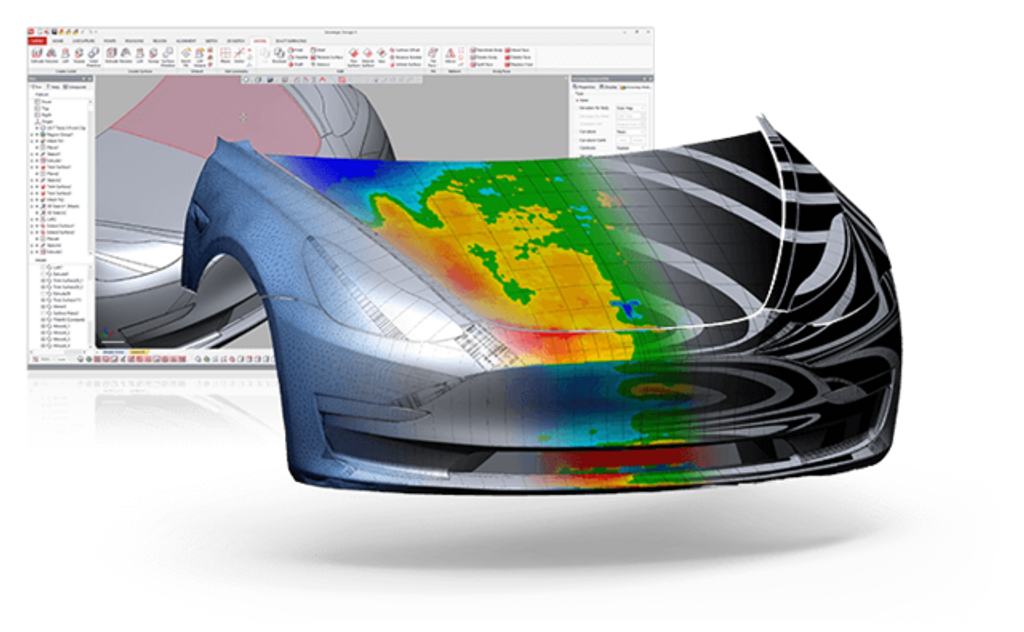 Automated 3D scanners collect data quickly and reliably, making them ideal for 3D scanning for manufacturing reengineering.
Automated 3D scanners collect data quickly and reliably, making them ideal for 3D scanning for manufacturing reengineering.
RobotScan E0505 automatic 3D scanning system: effective quality control solution for mass production
OptimScan 5M, FreeScan UE, FreeScan Trak can be used for RobotScanIn mass production of parts, the traditional inspection method involves the use of a coordinate measuring machine (CMM). Random inspection of a batch of products is carried out with low efficiency. The complexity lies in the performance of a set of works: measuring flatness, holes, their depth and distance between them, location points, geometric dimensions of the part, and so on.
In addition, extremely high reproducibility is required. In search of a method for checking a bulk batch of products while fulfilling the requirement for high measurement accuracy, Shining 3D engineers developed the RobotScan E0505 automatic 3D scanning system. nine0003
The robotic 3D inspection system combines two technologies: high-precision industrial 3D blue light scanning and unique intelligent inspection technology. The entire scanning process is completed with "one click", which greatly improves the control efficiency.
The entire scanning process is completed with "one click", which greatly improves the control efficiency.
How the intelligent complex works:
- Scanning a reference part and obtaining a set of key parameters. nine0010
- Importing key parameters into the Geomagic Control X program that creates the control data template.
- Batch quality control check of a sample batch of products and automatic generation of an error report in the program. The report can be imported into third-party software.
This algorithm allows you to optimize the production process, speed up the control work by an average of 10 times.
To get acquainted with the practical application of the RobotScan E0505 system, see the overview “RobotScan E0505 allows you to automatically check lots of auto parts”. The company used an automated 3D scanning system to perform automatic batch inspection of car engine cooler caps. nine0003
nine0003
Features and Benefits RobotScan E0505
The complex is designed specifically for automatic quality control. The apparatus enables the implementation of full-size inspection and mass automated control.
Advantages:
- high efficiency;
- high precision;
- labor savings;
- optimization of the production process.
The use of the automatic 3D scanning system RobotScan E0505 improves and optimizes the production process based on the generated report. Consequently, the product quality is greatly improved. nine0003
Properties:
- the ability to perform a full-size check by obtaining full point cloud data;
- availability of mass automatic control after programming just one
- high quality parts;
- high measurement speed and extended range of applications - single measurement is performed in 0.3 seconds, it is possible to process dark and shiny models without additional surface treatment with matting powder; nine0010
- The use of 3D scanning technology with structured blue light eliminates the glare of the metal surface;
- Guarantee of operational safety - the system is equipped with an optimal robot with extremely high protection;
- compact - the system takes up little space.
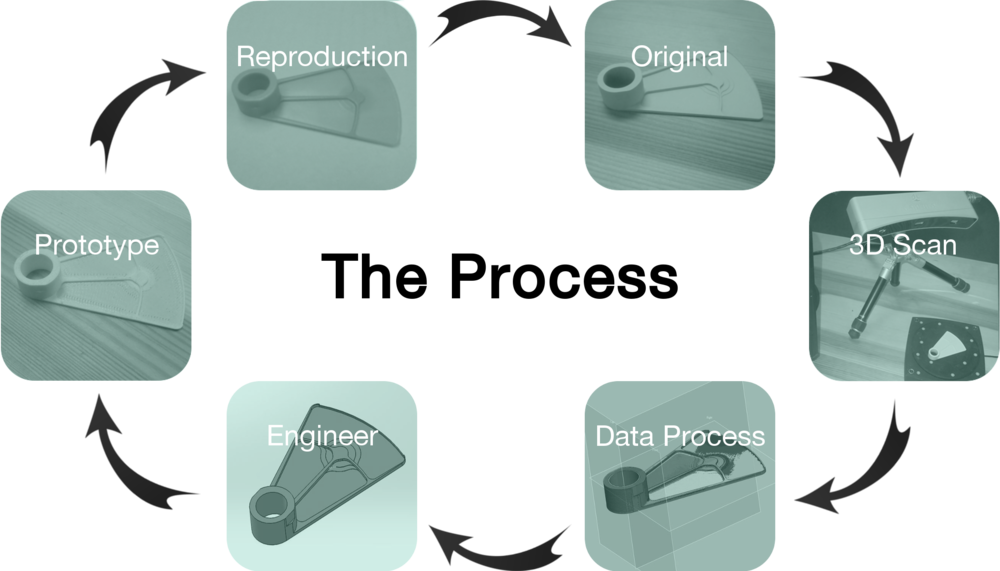
For on-site mass inspection, the RobotScan E0505 3D scanning system is ideal. Considering the possibility of importing a report created in the Geomagic Control X program into third-party applications, it is possible to establish communication between specialists. nine0003
Implementing the best 3D scanning solution allows manufacturers and engineers to save on labor and production costs because fewer iterations are required to produce a quality product. Since fewer employees perform repetitive tasks, they can devote more time to other parts of their workflow.
Handheld 3D Scanner in Manufacturing
Blue light 3D scanners are the most popular choice in manufacturing as they capture extremely high resolution 3D measurement data. With millions of precise data points from every fast scan, manufacturers get data from the entire surface in minutes. nine0003
Compared with a robot, a handheld 3D scanner is superior in convenience and flexibility, which helps in scanning a large object in a production workshop.
For reverse engineering, accurate data can be obtained with either a blue light 3D scanner or a handheld scanner. It is important to choose the best 3D scanner for your specific needs.
EinScan HX: A Handheld 3D Scanner for Industrial Applications
Shining 3D offers the EinScan HX handheld scanner with a hybrid blue LED and blue laser light source. This technology has made it possible to achieve exceptionally high scanning accuracy. nine0003
Despite the lightness and compact dimensions, the device has the capabilities of industrial designs. With the help of the 3D scanner EinScan HX, digital three-dimensional copies of large objects are obtained, from car parts to aircraft structural elements, from furniture to architectural objects.
The process of digitizing deep dark and shiny surfaces is easy. Devices from the line of expensive devices for 3D scanning have similar properties. nine0003
EinScan HX features that make it possible to use the 3D scanner for industrial applications:
- easy and convenient to use - plug and play device with user-friendly software
- able to digitize most objects for reverse engineering, CAD / CAM, 3D printing, etc.
 .;
.; - high scan speed;
- Performing a seamless scan.
High resolution and accuracy to meet the needs of industrial applications, including reverse engineering, measurement and quality control. nine0003
Reverse engineering workflow optimization
When choosing a 3D scanner for reverse engineering, it is important to consider the size of your project. Some 3D scanning methods are more efficient for collecting data from large objects, while a handheld scanner is sufficient for small objects.
For example, imagine the size of a small jet plane, and now imagine you are manually scanning it. A more efficient way to create a digital twin of an airplane-sized object is to combine 3D scanning technology with DigiMetric photogrammetry. nine0003
DigiMetric: The Next Generation 3D Optical Coordinate Measuring Machine
The DigiMetric Photogrammetry System is a revolutionary new approach to quickly measuring large objects. The equipment is a new generation of coordinate measuring machine - optical three-dimensional CMM.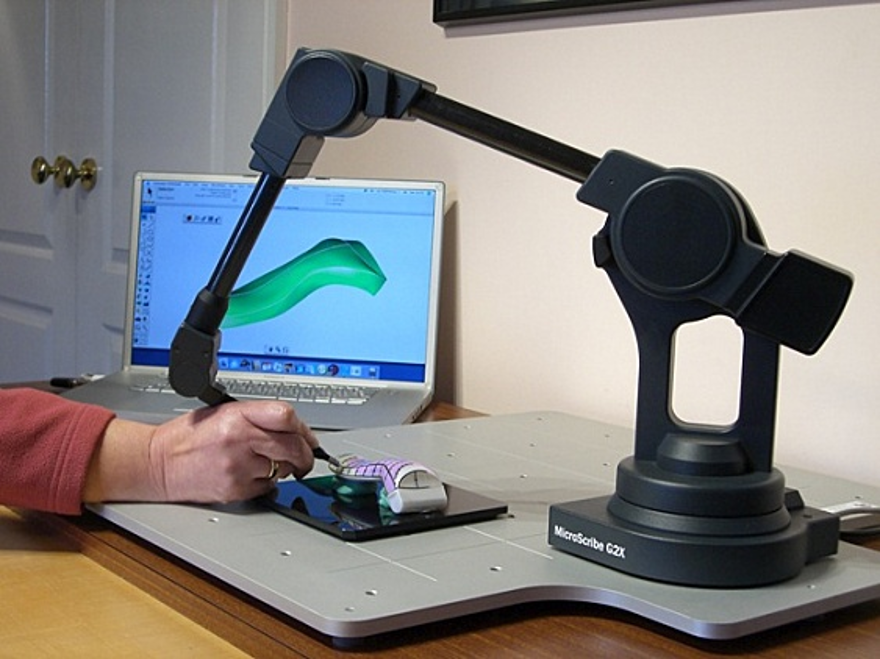 The applications of DigiMetric are almost limitless: heavy engineering companies, automakers, companies in the energy industry and other industrial sectors. How to scan large objects with high accuracy is described in the review "FreeScan UE and photogrammetry: how digital solutions help in 3D inspection of large parts." nine0003
The applications of DigiMetric are almost limitless: heavy engineering companies, automakers, companies in the energy industry and other industrial sectors. How to scan large objects with high accuracy is described in the review "FreeScan UE and photogrammetry: how digital solutions help in 3D inspection of large parts." nine0003
The measurement technique provided by the photogrammetric positioning system or DigiMetric near photogrammetric system is to obtain the three-dimensional coordinates of the reference point according to the principle of visual 3D calculation. Markers are placed on the surface of the object, the three-dimensional values of the coordinates of which are calculated by DigiMetric.
Features:
- capture area up to 5 meters;
- high scanning and processing speed;
- non-contact measurement;
- ease of operation;
- measurements both indoors and outdoors;
- portable and lightweight - the system can be carried by one person.

Some problems cannot be solved by traditional methods, and then photogrammetry becomes an ideal way. In addition, the time for data collection and analysis is significantly reduced. The DigiMetric system converts images of an object taken from several positions into a cloud of points, forming a three-dimensional body. nine0003
Thanks to the use of digitally calibrated scales, the dimensions of the object are determined with high precision. This is an important parameter for quality control. How digital solutions help in 3D inspection of large parts is described in the article "FreeScan UE and photogrammetry: how digital solutions help in 3D inspection of large parts".
The handheld 3D scanner is not operated by a mechanical arm that moves over an object to collect data points, but by a person. The person using the scanner stands at a distance from the object and scans it from the same distance around the entire perimeter. nine0003
Handheld 3D scanners accurately collect data from very small to very large objects, but take much longer to fully scan a large object. It is quite natural that human hands get tired after a certain time, so for large reverse engineering projects, it is necessary to use a different solution in the field of 3D metrology.
It is quite natural that human hands get tired after a certain time, so for large reverse engineering projects, it is necessary to use a different solution in the field of 3D metrology.
When reverse engineering, having accurate and clear data provides a better view of the object. With ideal data quality, it is easier to inspect and analyze the digital twin of an object for production and manufacturing. nine0003
If the data you collect is noisy, the process will take a long time due to numerous repetitive operations. If you need to focus on speed, automated 3D scanners will speed up the data collection process while eliminating the human factor. However, for smaller objects, an accurate handheld 3D scanner is a good option.
Reverse engineering steps
- Prepare the object for scanning, apply markers if necessary. Please note that glossy surfaces make it difficult for 3D scanners to work, and reflective or transparent surfaces are almost impossible to scan without a matte finish, so apply a temporary matte powder to the object to improve scanning accuracy.
 nine0010
nine0010 - Use the 3D scanner to capture important parts of a part. You may need to orient and rescan the object several times if it has holes or deep grooves.
- Adjust and optimize the resulting polygon mesh. Some scanners create very large files, making it difficult to post-process and print the object. Remove artifacts, check surface stitching.
- Import mesh into CAD software equipped with reverse engineering tools. nine0010
- Convert polygons to solids.
- If necessary, add new objects to the resulting 3D model or remove unnecessary ones.
- Use 3D printers or CNC machines to make a new part according to the created model.
Case Studies
EinScan Pro HD Application for Reengineering
A design, prototyping and 3D design company from Taiwan, Kiden Design, solved the problem of replacing a pipe on demand. The part was digitized using an EinScan Pro HD 3D scanner. The software allows you to transfer a three-dimensional model to any application for processing. The company's specialists chose the NX application for reverse engineering. nine0003
The company's specialists chose the NX application for reverse engineering. nine0003
The two parts of the pipe were scanned separately and connected in the scan processing program. Then, in the same program, a file for 3D printing was generated. A new optimized tube has been 3D printed. Read more https://www.shining3d.ru/blog/einscanner-of-the-week-3d-scanning-for-reverse-engineering/
Sunglasses repair using EinScan-SP scanner and Solid Edge software
If any element of the eyeglass frame is broken, you have to purchase new ones. But if the glasses are very expensive, or such a model has already been discontinued, you can print on a 3D printer only the damaged part. nine0003
To do this, the broken element is digitized by the EinScan-SP 3D scanner and the resulting 3D image is imported into the Solid Edge application. The integrity of the element is restored by software and a file for 3D printing is created. Now it remains only to print a new element of the eyeglasses on a 3D printer. Read more https://www.shining3d.ru/blog/how-to-bring-back-a-smile-rebuild-the-sunglasses-by-doing-reverse-engineering-through-einscan-sp-solid-edge /.
Read more https://www.shining3d.ru/blog/how-to-bring-back-a-smile-rebuild-the-sunglasses-by-doing-reverse-engineering-through-einscan-sp-solid-edge /.
Using 3D Scanning and Reverse Engineering to Create a Speaker Cart
The task was to create a cart to easily move a heavy speaker and recreate a lost speaker handle, one of three. Recreating the element was easy. Using the EinScan-SP 3D scanner, a digital copy of the pen was obtained. The image was corrected in the Meshmixer application, the STL file was received and sent to the FDM printer for printing.
To create the cart, the contact area of the speaker with the cart was digitized with an EinScan Pro 2X PLUS 3D scanner with EXSCAN PRO software to capture critical surface areas. The resulting scan was sent to Autodesk Fusion 360 to create a 3D cart model. It remains to print the finished 3D digital object on a 3D printer and add the necessary elements, such as wheels, etc. Read more about the case - https://www. shining3d.ru/blog/using-3d-scanning-and-reverse-engineering -to-build-a-cart-for-a-speaker/. nine0003
shining3d.ru/blog/using-3d-scanning-and-reverse-engineering -to-build-a-cart-for-a-speaker/. nine0003
EinScan HX and Verisurf: Quality Assurance and Reverse Engineering Platform
Engineers offer a unique design and inspection solution. The hybrid 3D scanner EinScan HX was chosen as a tool for obtaining a digital three-dimensional copy of the sample. This is an extremely accurate and reliable equipment that helps to scan complex-shaped parts with special surface characteristics: dark, shiny, with fine details.
The software developed by Shining3D partners was chosen for processing scans, generating data for analysis, performing calculations and comparison. This is an innovative software product Verisurf. nine0003
The EinScan HX high-end scanner and 3D measurement platform for production inspection, tooling and reverse engineering are combined to provide customers with a powerful package for a variety of manufacturing tasks. Read more about the case - https://www. shining3d.ru/news/einscan-hx-verisurf-platform-for-quality-control-and-reverse-engineering/
shining3d.ru/news/einscan-hx-verisurf-platform-for-quality-control-and-reverse-engineering/
Every day more and more companies and organizations are switching to using professional 3D scanners for projects related to reverse engineering. While many other tools exist for this purpose, 3D scanning has proven to be an effective solution that combines accuracy, speed, ease of use, and affordability. nine0003
For reverse engineering of any object - be it discontinued components that require accuracy down to tenths of a millimeter, cars, vans or even entire aircraft hangars - there are 3D scanners that can complete the task quickly, easily and without leaving beyond the budget.
3D scanners in reverse engineering
Supplier of 3D equipment since 2010
+7 495 646-15-33
3D scanners3D printersSoftwareServices
About the CompanyClients and ProjectsDemo HallGovernment ProcurementDeliveryService3D Encyclopedia
BlogContacts
Today, 3D scanners are widely used for reverse engineering of complex shapes. The process is characterized by the creation of a mathematical model or drawings from an existing physical model.
The process is characterized by the creation of a mathematical model or drawings from an existing physical model.
- How it works
- Benefits
- Case studies
- Videos
- How it works
- Benefits
- Examples of use
- Video
How it works
The concept of reverse engineering using a 3D scanner can be depicted as follows: 3D scanning of a physical sample, converting the resulting point cloud into a polygonal 3D model, processing the model in special software software for conversion to CAD format.
How it works
A reverse engineering concept using a 3D scanner can be depicted as follows: 3D scanning of a physical sample, converting the resulting point cloud into a polygonal 3D model, processing the model in special software for converting to CAD format. nine0003
Based on the received CAD model, tools are created for mass production of the finished product. If necessary, changes and improvements are made to the resulting model. Let's consider this process using the example of reverse engineering of an industrial fan casing.
If necessary, changes and improvements are made to the resulting model. Let's consider this process using the example of reverse engineering of an industrial fan casing.
On the basis of the obtained CAD model, tools are created for mass production of the finished product. If necessary, changes and improvements are made to the resulting model. Let's consider this process using the example of reverse engineering of an industrial fan housing. nine0003
1. We disassemble the test product into the maximum number of components.
2. We scan each element using an optical or laser 3D scanner. We get a cloud of points with data on surfaces and geometry of objects.
1. We disassemble the test product into the maximum number of components.
2. We scan each element using an optical or laser 3D scanner. We get a cloud of points with data on surfaces and geometry of objects. nine0003
3. Using the software, convert the point cloud into a polygonal 3D model.
4. We convert the data into a convenient CAD format (the process depends on the technical requirements and features of the software used).
We convert the data into a convenient CAD format (the process depends on the technical requirements and features of the software used).
3. Using the software, we convert the point cloud into a polygonal 3D model.
4. We convert the data into a convenient CAD format (the process depends on the technical requirements and features of the software used). nine0003
Benefits
There is a fine line between digital modeling and reverse engineering. Sometimes both methods can be correct in solving problems with 3D models. However, reverse engineering has a number of advantages. Here are some of them:
- the model can be loaded into parametric modeling programs;
- the parametric model will have key construction points, with the ability to edit;
- Unlike artificially modeled surfaces, reverse engineering models contain more geometric features, making them more suitable for design and measurement; nine0010
- reverse engineering models are great for CFD and FEA engineering analysis programs (Such as ANSYS).
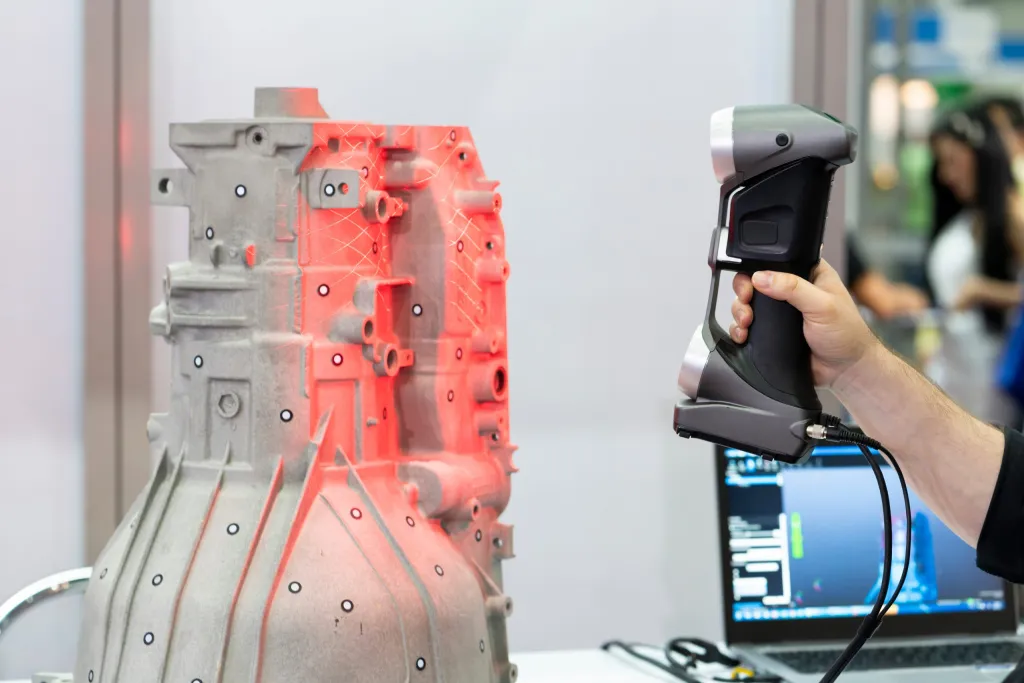
Benefits
There is a fine line between digital modeling and reverse engineering. Sometimes both methods can be correct in solving problems with 3D models. However, reverse engineering has a number of advantages. Here are some of them:
- the model can be loaded into parametric modeling programs;
- the parametric model will have key construction points, with the ability to edit; nine0010
- Unlike artificially modeled surfaces, reverse engineering models contain more geometric features, making them more suitable for design and measurement;
- reverse engineering models are great for CFD and FEA engineering analysis programs (Such as ANSYS).
Examples of using 3D scanners in reverse engineering This item has been out of production for a long time. Based on the surviving part, its exact 3D copy was recreated, which was subsequently printed on a 3D printer in the required quantity just in time.
 With conventional production tools, it would have been impossible to fulfill an order within a narrow time frame. nine0003
With conventional production tools, it would have been impossible to fulfill an order within a narrow time frame. nine0003 The design bureau of the US Space Agency needed to develop a new product, relying on the basis of existing solutions. Such tasks often arise in connection with the need to save budget funds. In this case, the 3D scanner also turned out to be indispensable - scanning technology significantly saved money and time, becoming an alternative to expensive modeling.
Examples of using 3D scanners in reverse engineering This item has been out of production for a long time. Based on the surviving part, its exact 3D copy was recreated, which was subsequently printed on a 3D printer in the required quantity just in time. With conventional production tools, it would have been impossible to fulfill an order within a narrow time frame. nine0003
The design bureau of the US Space Agency needed to develop a new product, relying on the basis of existing solutions.


